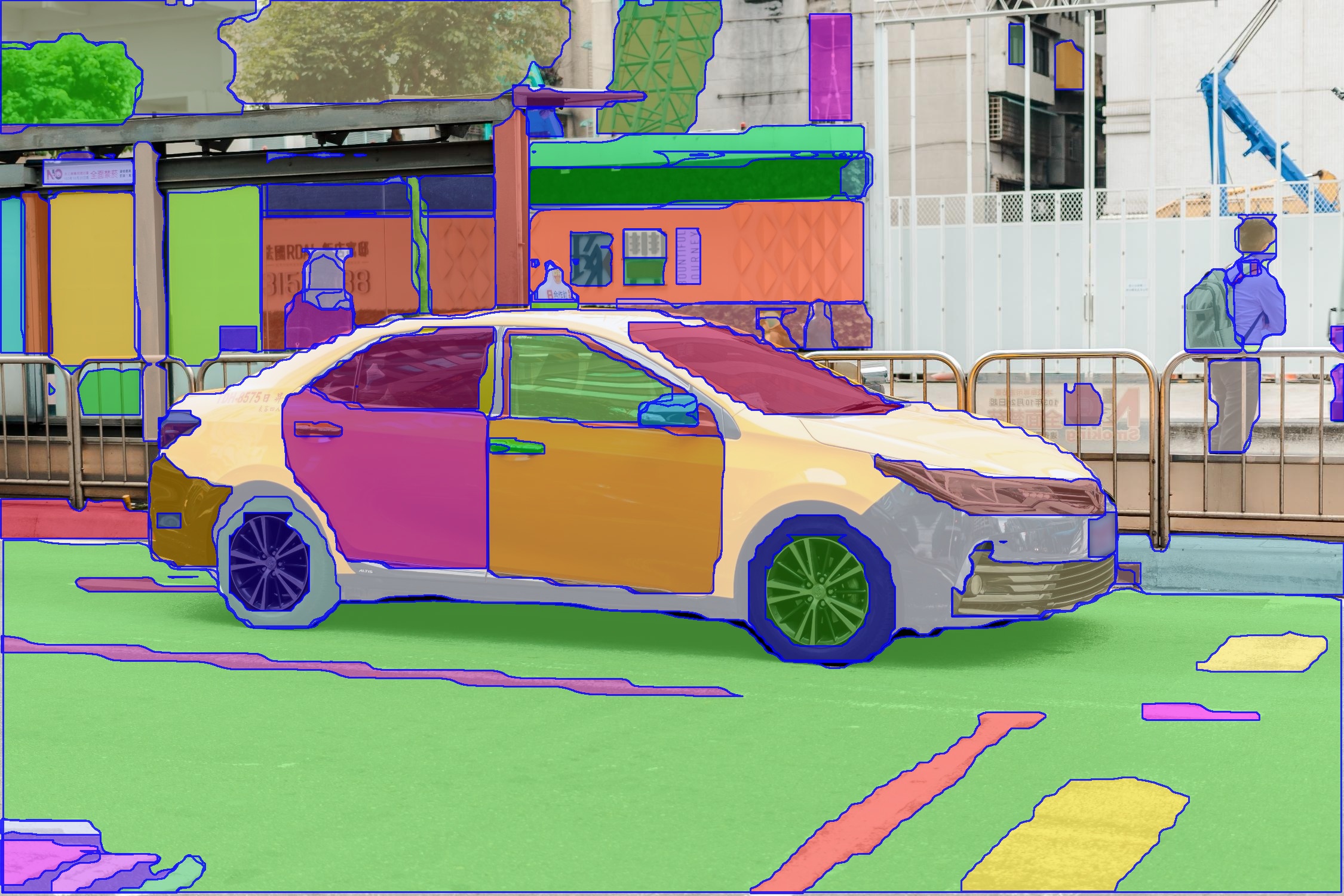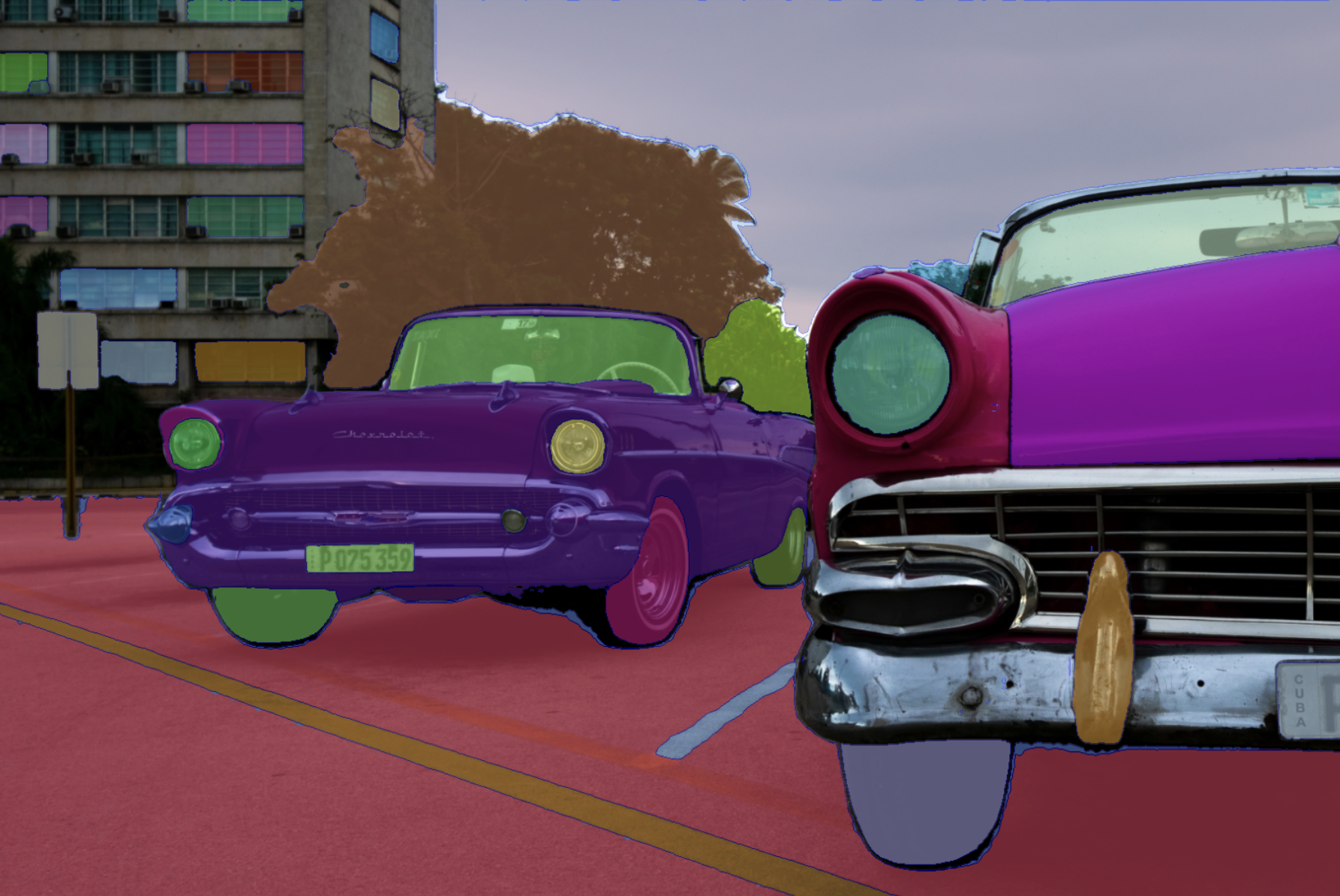fastsam
Maintainer: casia-iva-lab

24

| Property | Value |
|---|---|
| Run this model | Run on Replicate |
| API spec | View on Replicate |
| Github link | View on Github |
| Paper link | View on Arxiv |
Create account to get full access
Model overview
The fastsam model is a fast version of the Segment Anything Model (SAM), a powerful deep learning model for image segmentation. Unlike the original SAM, which uses a large ViT-H backbone, fastsam uses a more efficient YOLOv8x architecture, allowing it to achieve similar performance at 50x higher runtime speed. This makes it a great option for real-time or mobile applications that require fast and accurate object segmentation. The model was developed by the CASIA-IVA-Lab and is open-source, allowing developers to easily integrate it into their projects.
The fastsam model is similar to other open-source AI models like segmind-vega, which also aims to provide a faster alternative to large, computationally expensive models. However, fastsam specifically targets the Segment Anything task, offering a unique and specialized solution. It's also similar to the original Segment Anything model, but with a much smaller and faster architecture.
Model inputs and outputs
Inputs
- input_image: The input image for which the model will generate segmentation masks.
- text_prompt: A text description of the object to be segmented, e.g., "a black dog".
- box_prompt: The bounding box coordinates of the object to be segmented, in the format
[x1, y1, x2, y2]. - point_prompt: The coordinates of one or more points on the object to be segmented, in the format
[[x1, y1], [x2, y2]]. - point_label: The label for each point, where 0 indicates background and 1 indicates foreground.
Outputs
- segmentation_masks: The segmentation masks generated by the model for the input image, with one mask for each object detected.
- confidence_scores: The confidence scores for each segmentation mask, indicating the model's certainty about the object detection.
Capabilities
The fastsam model is capable of generating high-quality segmentation masks for objects in images, even with minimal input prompts. It can handle a variety of object types and scenes, from simple objects like pets and vehicles to more complex scenes with multiple objects. The model's speed and efficiency make it well-suited for real-time applications and embedded systems, where the original SAM model may be too computationally expensive.
What can I use it for?
The fastsam model can be used in a wide range of computer vision applications that require fast and accurate object segmentation, such as:
- Autonomous driving: Segmenting vehicles, pedestrians, and other obstacles in real-time for collision avoidance.
- Robotics and automation: Enabling robots to perceive and interact with objects in their environment.
- Photo editing and content creation: Allowing users to easily select and manipulate specific objects in images.
- Surveillance and security: Detecting and tracking objects of interest in video streams.
Things to try
One interesting aspect of the fastsam model is its ability to perform well on a variety of zero-shot tasks, such as edge detection, object proposals, and instance segmentation. This suggests that the model has learned generalizable features that can be applied to a range of computer vision problems, beyond just the Segment Anything task it was trained on.
Developers and researchers could experiment with using fastsam as a starting point for transfer learning, fine-tuning the model on specific datasets or tasks to further improve its performance. Additionally, the model's speed and efficiency make it a promising candidate for deployment on edge devices, where the real-time processing capabilities could be highly valuable.
This summary was produced with help from an AI and may contain inaccuracies - check out the links to read the original source documents!
Related Models

sam-vit

48
The sam-vit model is a variation of the Segment Anything Model (SAM), a powerful AI model developed by Facebook research that can generate high-quality object masks from input prompts such as points or bounding boxes. The SAM model has been trained on a dataset of 11 million images and 1.1 billion masks, giving it strong zero-shot performance on a variety of segmentation tasks. The sam-vit model specifically uses a Vision Transformer (ViT) as the image encoder, compared to other SAM variants like the sam-vit-base and sam-vit-huge models. This ViT-based encoder computes image embeddings using attention on patches of the image, with relative positional embedding used. Similar models to sam-vit include the fastsam model, which aims to provide fast segment-anything capabilities, and the ram-grounded-sam model, which combines the SAM model with a strong image tagging model. Model inputs and outputs Inputs source_image**: The input image file to generate segmentation masks for. Outputs Output**: The generated segmentation masks for the input image. Capabilities The sam-vit model can be used to generate high-quality segmentation masks for objects in an image, based on input prompts such as points or bounding boxes. This allows for precise object-level segmentation, going beyond traditional image segmentation approaches. What can I use it for? The sam-vit model can be used in a variety of applications that require accurate object-level segmentation, such as: Object detection and instance segmentation for computer vision tasks Automated image editing and content-aware image manipulation Robotic perception and scene understanding Medical image analysis and disease diagnosis Things to try One interesting aspect of the sam-vit model is its ability to perform "zero-shot" segmentation, where it can automatically generate masks for all objects in an image without any specific prompts. This can be a powerful tool for exploratory data analysis or generating segmentation masks at scale. Another interesting direction to explore is combining the sam-vit model with other AI models, such as the ram-grounded-sam model, to leverage both the segmentation capabilities and the image understanding abilities of these models.
Updated Invalid Date

sam-2

5
SAM 2: Segment Anything in Images and Videos is a foundation model for solving promptable visual segmentation in images and videos. It extends the original Segment Anything Model (SAM) by Meta to support video processing. The model design is a simple transformer architecture with streaming memory for real-time video processing. SAM 2 is trained on the Segment Anything Video (SA-V) dataset, the largest video segmentation dataset to date, providing strong performance across a wide range of tasks and visual domains. Model inputs and outputs The SAM 2 model takes an image or video as input and allows users to provide prompts (such as points, boxes, or text) to segment relevant objects. The outputs include a combined mask covering all segmented objects as well as individual masks for each object. Inputs Image**: The input image to perform segmentation on. Use M2M**: A boolean flag to use the model-in-the-loop data engine, which improves the model and data via user interaction. Points Per Side**: The number of points per side for mask generation. Pred Iou Thresh**: The predicted IoU threshold for mask prediction. Stability Score Thresh**: The stability score threshold for mask prediction. Outputs Combined Mask**: A single combined mask covering all segmented objects. Individual Masks**: An array of individual masks for each segmented object. Capabilities SAM 2 can be used for a variety of visual segmentation tasks, including interactive segmentation, automatic mask generation, and video segmentation and tracking. It builds upon the strong performance of the original SAM model, while adding the capability to process video data. What can I use it for? SAM 2 can be used for a wide range of applications that require precise object segmentation, such as content creation, video editing, autonomous driving, and robotic manipulation. The video processing capabilities make it particularly useful for applications that involve dynamic scenes, such as surveillance, sports analysis, and live event coverage. Things to try With SAM 2, you can experiment with different types of prompts (points, boxes, or text) to see how they affect the segmentation results. You can also try the automatic mask generation feature to quickly isolate objects of interest without manual input. Additionally, the video processing capabilities allow you to track objects across multiple frames, which could be useful for applications like motion analysis or object tracking.
Updated Invalid Date
🤔
ram-grounded-sam

1.3K
ram-grounded-sam is an AI model that combines the strengths of the Recognize Anything Model (RAM) and the Grounded-Segment-Anything model. It exhibits exceptional recognition abilities, capable of detecting and segmenting a wide range of common objects in images using free-form text prompts. This model builds upon the powerful Segment Anything Model (SAM) and the Grounding DINO detector to provide a robust and versatile tool for visual understanding tasks. Model inputs and outputs The ram-grounded-sam model takes an input image and a text prompt as inputs, and generates segmentation masks for the objects and regions described in the prompt. The text prompt can be a free-form description of the objects or scenes of interest, allowing for flexible and expressive control over the model's behavior. Inputs Image**: The input image for which the model will generate segmentation masks. Text Prompt**: A free-form text description of the objects or scenes of interest in the input image. Outputs Segmentation Masks**: The model outputs a set of segmentation masks, each corresponding to an object or region described in the text prompt. These masks precisely outline the boundaries of the detected entities. Bounding Boxes**: The model also provides bounding boxes around the detected objects, which can be useful for tasks like object detection or localization. Confidence Scores**: The model outputs confidence scores for each detected object, indicating the model's certainty about the presence and precise segmentation of the corresponding entity. Capabilities The ram-grounded-sam model is capable of detecting and segmenting a wide variety of common objects and scenes in images, ranging from everyday household items to complex natural landscapes. It can handle prompts that describe multiple objects or scenes, and can accurately segment all the relevant entities. The model's strong zero-shot performance allows it to generalize to new domains and tasks beyond its training data. What can I use it for? ram-grounded-sam can be a powerful tool for a variety of computer vision and image understanding tasks. Some potential applications include: Automated Image Annotation**: The model can be used to automatically generate detailed labels and masks for the contents of images, which can be valuable for building and annotating large-scale image datasets. Interactive Image Editing**: By providing precise segmentation of objects and regions, the model can enable intuitive and fine-grained image editing capabilities, where users can select and manipulate specific elements of an image. Visual Question Answering**: The model's ability to understand and segment image contents based on text prompts can be leveraged to build more advanced visual question answering systems. Robotic Perception**: The model's real-time segmentation capabilities could be integrated into robotic systems to enable more fine-grained visual understanding and interaction with the environment. Things to try One interesting aspect of the ram-grounded-sam model is its ability to handle complex and open-ended text prompts. Try providing prompts that describe multiple objects or scenes, or use more abstract or descriptive language to see how the model responds. You can also experiment with providing the model with challenging or unusual images to test its generalization capabilities. Another interesting direction to explore is combining ram-grounded-sam with other AI models, such as language models or generative models, to enable more advanced image understanding and manipulation tasks. For example, you could use the model's segmentation outputs to guide the generation of new image content or the editing of existing images.
Updated Invalid Date

sdxl-lightning-4step

412.2K
sdxl-lightning-4step is a fast text-to-image model developed by ByteDance that can generate high-quality images in just 4 steps. It is similar to other fast diffusion models like AnimateDiff-Lightning and Instant-ID MultiControlNet, which also aim to speed up the image generation process. Unlike the original Stable Diffusion model, these fast models sacrifice some flexibility and control to achieve faster generation times. Model inputs and outputs The sdxl-lightning-4step model takes in a text prompt and various parameters to control the output image, such as the width, height, number of images, and guidance scale. The model can output up to 4 images at a time, with a recommended image size of 1024x1024 or 1280x1280 pixels. Inputs Prompt**: The text prompt describing the desired image Negative prompt**: A prompt that describes what the model should not generate Width**: The width of the output image Height**: The height of the output image Num outputs**: The number of images to generate (up to 4) Scheduler**: The algorithm used to sample the latent space Guidance scale**: The scale for classifier-free guidance, which controls the trade-off between fidelity to the prompt and sample diversity Num inference steps**: The number of denoising steps, with 4 recommended for best results Seed**: A random seed to control the output image Outputs Image(s)**: One or more images generated based on the input prompt and parameters Capabilities The sdxl-lightning-4step model is capable of generating a wide variety of images based on text prompts, from realistic scenes to imaginative and creative compositions. The model's 4-step generation process allows it to produce high-quality results quickly, making it suitable for applications that require fast image generation. What can I use it for? The sdxl-lightning-4step model could be useful for applications that need to generate images in real-time, such as video game asset generation, interactive storytelling, or augmented reality experiences. Businesses could also use the model to quickly generate product visualization, marketing imagery, or custom artwork based on client prompts. Creatives may find the model helpful for ideation, concept development, or rapid prototyping. Things to try One interesting thing to try with the sdxl-lightning-4step model is to experiment with the guidance scale parameter. By adjusting the guidance scale, you can control the balance between fidelity to the prompt and diversity of the output. Lower guidance scales may result in more unexpected and imaginative images, while higher scales will produce outputs that are closer to the specified prompt.
Updated Invalid Date